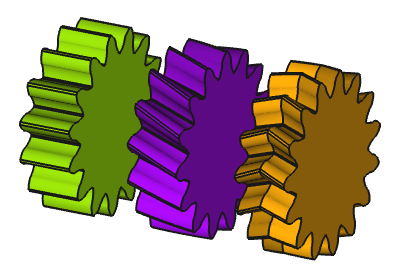FCGear: Ingranaggio cicloidale
|
|
| Posizione nel menu |
|---|
| Gear → Cycloid Gear |
| Ambiente |
| FCGear |
| Avvio veloce |
| None |
| Introdotto nella versione |
| v0.16 |
| Vedere anche |
| FCGear: Ingranaggio ad evolvente esterno |
Descrizione
Gli ingranaggi cicloidali sono molto sensibili agli errori nell'interasse, che portano ad una variazione del rapporto di trasmissione. Per questi motivi gli ingranaggi cicloidali non si trovano quasi mai nell'ingegneria meccanica, ma vengono utilizzati solo in casi speciali come nell'industria orologiera, per le pompe a lobi o per l'azionamento di cremagliere.
Da sinistra a destra: ingranaggio cilindrico, ingranaggio elicoidale, ingranaggio elicoidale doppio
Utilizzo
- Passare a
FCGear.
- Esistono diversi modi per richiamare il comando:
- Premere il pulsante
Cycloid Gear nella barra degli strumenti.
- Selezionare l'opzione Gear →
Cycloid Gear dal menu.
- Premere il pulsante
- Modificare il parametro dell'ingranaggio alle condizioni richieste (vedere Proprietà).
Proprietà
Dati
Un oggetto FCGear CycloidGear deriva da un oggetto Part Feature e ne eredita tutte le proprietà. Ha inoltre le seguenti proprietà aggiuntive:
accuracy
- Datinumpoints (
Integer): L'impostazione predefinita è15. Diverso rispetto al profilo dell'evolvente. La modifica del valore può portare a risultati imprevisti.
base
- Datiheight (
Length): Default is5 mm. Value of the gear width. - Datimodule (
Length): Default is1 mm. Module is the ratio of the reference diameter of the gear divided by the number of teeth (see Notes). - Datiteeth (
Integer): Default is15. Number of teeth.
computed
- Datiangular_backlash (
Angle): (sola lettura) - Datidw (
Length): (sola lettura) Diametro primitivo di lavoro.
cycloid
- Datiinner_diameter (
Float): (read-only) Diameter of the rolling circle of hypocycloid, normalized by the Datimodule (see Notes). - Datiouter_diameter (
Float): Default is7.5. Diameter of the rolling circle of epicycloid, normalized by the Datimodule (see Notes).
fillets
- Datihead_fillet (
Float): Default is0 mm. - Datiroot_fillet (
Float): Default is0 mm.
helical
- Datibeta (
Angle): Default is0 °. With the helix angle β a helical gear is created – positive value → rotation direction right, negative value → rotation direction left. - Datidouble_helix (
Bool): Default isfalse,truecreates a double helix gear (see Notes).
tolerance
- Datibacklash (
Length): Default is0. Backlash, also called lash or play, is the distance between the teeth at a gear pair.
- Daticlearance (
Float): Default is0.25(see Notes). - Datihead (
Float): Default is0. Additional length of the tip of the teeth, normalized by the Datimodule.
version
- Dativersion (
String):
Note
- Cycloidal gears must always be specially matched to each other and can generally not be exchanged at will: In a gear pair, the value of inner_diameter on one gear must equal the outer_diameter on the other, and vice versa. See also the information in Properties cycloid parameter view below.
- clearance: At a gear pair, clearance is the distance between the tooth tip of the first gear and the tooth root of the second gear.
- double_helix: To use the double helical gearing the helix angle β (beta) for the helical gearing must first be entered.
- module: Using ISO (International Organization for Standardization) guidelines, Module size is designated as the unit representing gear tooth-sizes. Module (m): m = 1 (p = 3.1416), m = 2 (p = 6.2832), m = 4 (p = 12.566). If you multiply Module by Pi, you can obtain Pitch (p). Pitch is the distance between corresponding points on adjacent teeth.
Casi particolari
La linea retta come ipocicloide
To obtain a straight line, directly towards the center, as hypocycloid, use the following expression for the Datiinner_diameter: teeth / 2. Such a tooth form is often found in historical clockworks and thus called "clock toothing". A larger Daticlearance makes the effect even more visible.
Full hypocycloid/epicycloid as tooth
To obtain a gear made of complete hypocycloid and epicycloid curves use the following expressions:
- Datiinner_diameter:
0.5 + 1e-6 - Datiouter_diameter:
inner_diameter - Daticlearance:
(-1 + inner_diameter/1mm) * 2 - Datihead:
(-1 + outer_diameter/1mm) * 2
The reference diameter is d = m * z, with m being the Datimodule and z being the Datiteeth.
For a complete hypocycloid, the rolling diameter has to be d_i = d / (z*2) = m*z / (z*2). And if we now normalize this by the module, we get d_in = m*z / (z*2) / m = 1 / 2. The additional explicit tolerance value (1e-6 in the expression above) is required to overcome coincidence issues.
Now the cycloids' rolling circle diameters have to match the gear's addedum/dedendum. The addendum, i.e. the tooth length above the reference circle, is 1 + Datihead. The dedendum, i.e. the tooth length below the reference circle, is 1 + Daticlearance. Both are normalized by the module, thus we need a head/clearance value of 1 - d_in. The additional / 1mm and * 2 are required to overcome shortcomings already fixed in the development version of the FCGear Workbench, but porting those fixes back to the stable version may break existing models.
Such "gears" allow the the number of teeth to be as low as two and are used as rotary vanes in pumps or compressors (cf. Roots-type Supercharger).
Infinitely large epicycloid
If the radius of the epicycloid's rolling circle becomes infinitely large, it becomes a rolling straight line. Such a degenerated epicycloid is called involute. Gears with such a tooth form are handled by the involute gear command. It is by far the most common tooth form Today.
Formule utili
See FCGear InvoluteGear.
Properties cycloid parameter view



